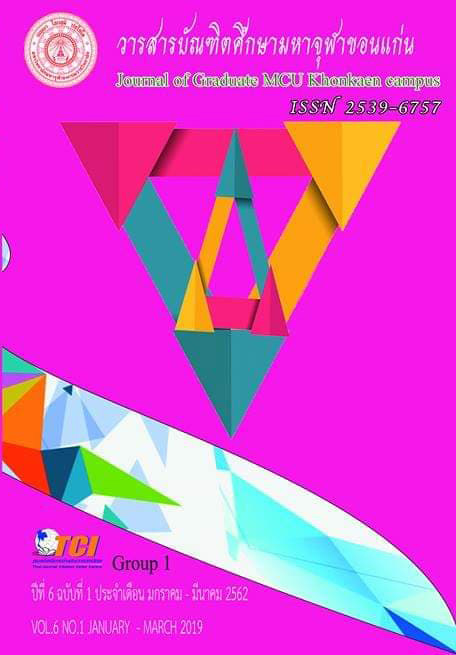Buddhist Dhamma Principles as Appeared In Buddhist Art in KhonKaen
Main Article Content
Abstract
Temple is religious place which it sources of arts, culture and Buddhist Arts, each region was different. Buddhist Arts in Khon Kaen Province had identity and prominent especially SIM and painting in the areas of the five temples i.e. 1) Wat chaisri,Ban Sawatthee 2) Wat Sanaunwaree, Banhuanong, 3) Wat Matchimawitthayaram, Ban Lan, 4) Wat Sra Bua Keo, Ban Wang Kun, 5) Wat Sra Thong, Ban Bua. Dhamma doctrines appeared were divided into SIMA which was mind center of community because the tempie established by faith and unity of peopie in the community. Its also were the respected places of villagers including important learning sources for education to creat wisdom for the community. The painting reflected to the 8 LOKA-dhamma which exists with the world. The 8 LOKA-dhamma was media for Dhamma peaching which applied in daily life. It was influented to culture and tradition in the community. It was an important because it sparkles for the preservation of art objects and mutual awareness in learning source of Buddhism as well.
Article Details
References
T.Wattana Kanrnpim.
Fine Arts Department. (1990). Importtant Temples in Rattanakosin. Bangkok:
Fine Arts Department.
Khunthokhan. (1994). Buddhism and Daily Life. Bangkok: Odean Store.
Panyathapsingh. (2005). Asia Art. Bangkok: Active prit Ltd.
Sanguan Rodboon. (1990 ) . Sukhothai Buddhist Art. Bangkok: O.S.Printing
House.
Somchat Manichot. (1986). Thai Painting. Bangkok: Odean Store Publishing.
Thanit Yoopho. (1 9 64 ). Theory in Improving and Preservation of Religious
Places in the Temple. Bangkok: Sivaponkarnpim.
The Crown Property Bureau. (2016 ) . Hand book of Religious Places Care
B.E. 2559. Bangkok: The Crown Property Bureau.
Wirot Srisuro. (1989). Sim Esarn. Bangkok: Mekha Plase.
Wisut Pinyovanichka. (1985). Thai Painting. Department of fine Arts, Faculty
of Humanity and Social Science. Buriram: Buriram Teacher
College.
Phrama Mit Thitapanyo. ( 2 0 1 8 ) . The Controversies and Interpretation of a
Holy Precept in Buddhism. Dhammathas Academic Journal, 18(1),
211-222.

